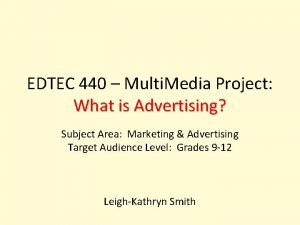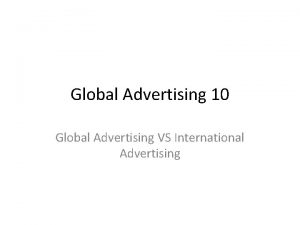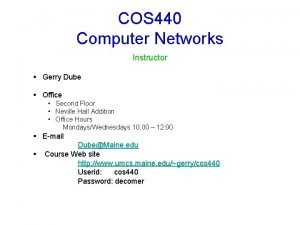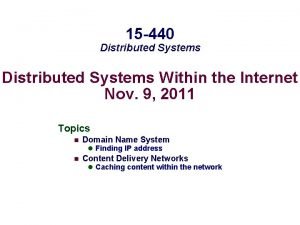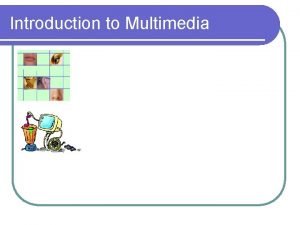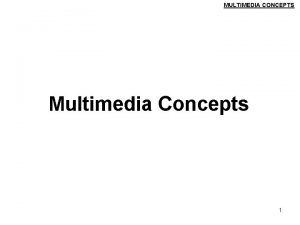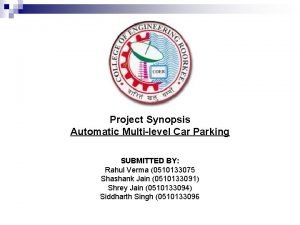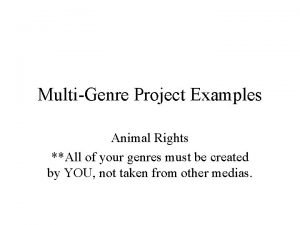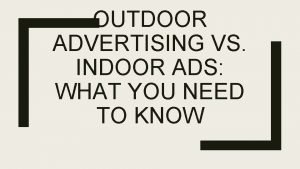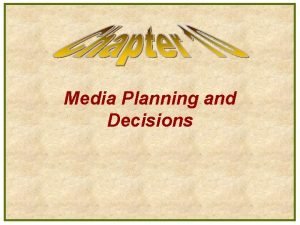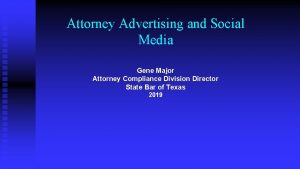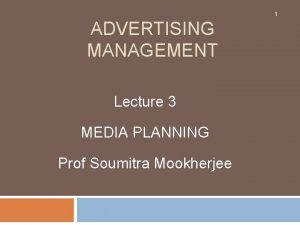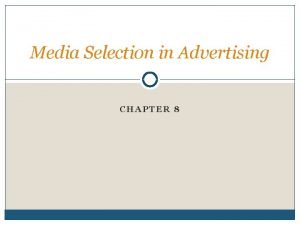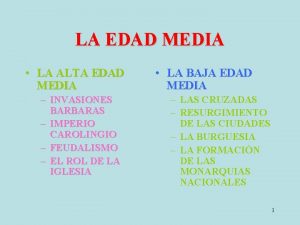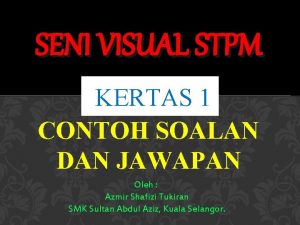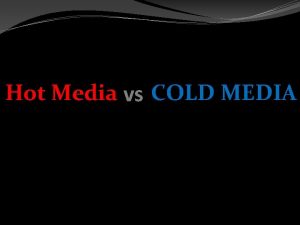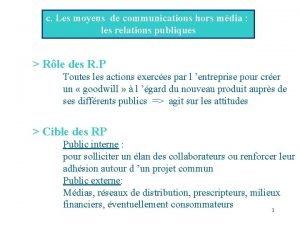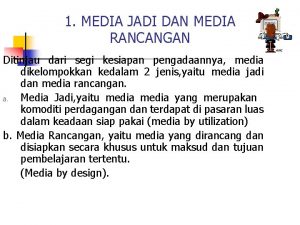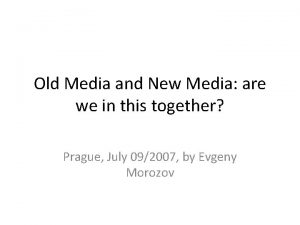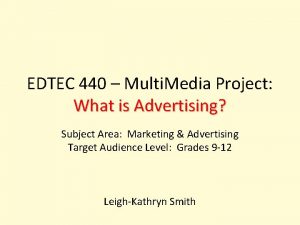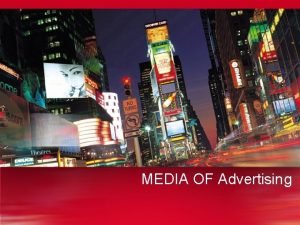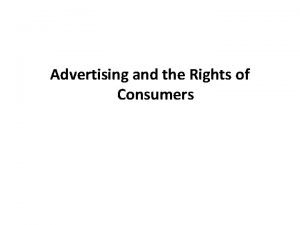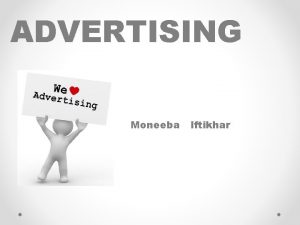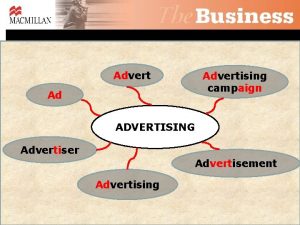EDTEC 440 Multi Media Project What is Advertising





























































- Slides: 61

EDTEC 440 – Multi. Media Project: What is Advertising? Subject Area: Marketing & Advertising Target Audience Level: Grades 9 -12 Leigh-Kathryn Smith

An Introduction • The main objectives of this lesson/tutorial are: – To provide supplemental information that is not included in the textbook – To incorporate the Advertising Podcast – To provide 2 quick assessments

Navigation Key • Each section has it’s own unique navigation button for use within the section. • This button will always be the last element to appear on a slide. • Here are each of the Navigation Buttons: BA ITB ~ Click to return to this Before Advertising slide ~ Click to return to this In The Beginning slide AM ~ Click to return to this Advertising Matures slide AT ~ Click to return to this Advertising Today slide AT ~ Click to return to this Advertising Tomorrow slide A-MT M ~ Click to return to this Adv-Mktg Tools slide ~ Click to Return to this Media slide TM ~ Click to Return to this Target Markets slide ~ Click to return to the Timeline slide ~ Click to return to this Types of Advertising slide To. A ~ This brings user back to main Advertising page (index)


What is Advertising? • Evolution of Advertising • Types of Advertising – Top Slogan - Quiz • Advertising as a Marketing Tool • Advertising Media – Print • Video – Broadcast – Other • Target Markets • Pros & Cons of Advertising ~ Click on this symbol to return to this Advertising Home page

1800 s Adv ert Ma isin tur g es In T Beg he inn ing Bef Ad o ver re tisi ng 1900 s Adv Tod ertisi ng ay ~ Click to return to this Timeline slide 2000 s Ad ver Tom tisi orr ng ow on 184 4 185 - Tele 0 – In graph ter 186 sew chan g 4 – U ing m eable t. S. rai achin part s & lroa e o c o d a 192 co st ast 0 – A Il ds inc 193 lust lud 0 - rati e 195 Rad ons 0 - io Tel evi sio n olu ti 170 4 – Fi n rst ad 175 ew s in 0 – spa Ind pe ust r rial Re v Evolution of Advertising

1800 s Adv ert Ma isin tur g es In T Beg he inn ing Bef Ad o ver re tisi ng 1900 s Adv Tod ertisi ng ay ~ Click to return to this Timeline slide 2000 s Ad ver Tom tisi orr ng ow on 184 4 185 - Tele 0 – In graph ter 186 sew chan g 4 – U ing m eable t. S. rai achin part s & lroa e o c o d a 192 co st ast 0 – A Il ds inc 193 lust lud 0 - rati e 195 Rad ons 0 - io Tel evi sio n olu ti 170 4 – Fi n rst ad 175 ew s in 0 – spa Ind pe ust r rial Re v Evolution of Advertising

Before Advertising • Products and services were exchanged long before Advertising, per say, existed. • Growing populations and villages set the stage for the birth and rise of Advertising. – Early Households – Early Towns – Early Commerce BA ~ Click to return to this Before Advertising slide

Early Households • Early households were self-sufficient • Each house had ample land surrounding it – Used for raising crops – Used for raising livestock • Clothing was designed and made from available materials – Cloth from yarn – Leather from cattle • Homes were built from available materials – Wood – Rocks BA

Early Towns • People gathered into towns as populations grew for – Protection – Commerce • Towns did not provide for crops or livestock • Residents not able to remain self-sufficient • Specialization began in the trades – Candlemakers – Tailors – Food (fruit, bread, meat) • Residents became interdependent – Relied on others for things they themselves couldn’t provide BA

Early Commerce • Specialization brought with it bartering • Candlemaker traded candles for bread from the baker • Baker traded bread to tailor for clothing • Bartering became outdated – As more people specialize, bartering for everything became too complicated • i. e. : baker might want glass for his windows, but the glassmaker didn’t want bread • People sold products for something everyone valued—gold • A free market economy ruled by supply and demand was born. 5 BA

In The Beginning • A free market economy is an important factor in Advertising • Supply & demand inspires competing businesses to advertise as a means for increasing demand for their products – Before 1800 – Industrial Revolution – The 1800 s ITB ~ Click to return to this In The Beginning slide

Before 1800 • Towns became cities – Created large groups of people that could be targeted by advertising – New technology and inventions made it possible to distribute information to many at one time – Advertising was born • In 1704, the Boston News Letter contained paid advertisements for – – Real estate The return of lost items Text only Illustrations didn’t appear until much later ITB

The Industrial Revolution • The Industrial Revolution changed the world in many ways – Start – 1750 in England – Spread slowly until the 1800 s – 1850 mass production made possible • Interchangeable parts • Introduction of the perfected sewing machine – Companies could make large numbers of items • • • Needed to stimulate demand for these items Stimulation came through Advertising became necessary for growing businesses ITB

The 1800 s • Additional events caused boom in business and advertising – Invention of telegraph – 1844 • Created a way of communicating at greater speeds over long distances – Transportation • Changed forever – Railroad connected east and west coasts-1864 • Opened distant markets for local companies – Media • 1850 – newspaper circulation estimated reach – 1 million copies per day – Mass Media was ready to deliver advertising to over a million people a day • The first Advertising Agent, Volney Palmer, opened his doors for business in Philadelphia ITB

Advertising Matures • Advertising took a more modern look • Illustrations began to give advertisement the look we are used to seeing today – The 1900 s – Radio vs. Television AM ~ Click to return to this Advertising Matures slide

The 1900 s • Ads became more visual • Advertisements from the 1920 s were so beautifully illustrated that they are often considered works of art today AM

Radio vs. Television – Radio • 1930 s – Radio emerges as an effective advertising medium • Remained most significant medium for advertising until television appeared in the 1950 s – Television • • 1960 – about 90% of American homes had TVs Advertising thrived in the TV arena Beginning – advertisements focused on the product 1990 s – Advertisers learned quickly, and commercials were now slick and polished AM

Advertising Today • Advertisers have learned from experience – Today’s advertising is fast and slick • Consumers have learned too – Today’s consumer is knowledgeable and sophisticated • Advertising Today - Overview • Advertising Media Today • The Internet Today AT ~ Click to return to this Advertising Today slide

Advertising Today – Overview • Today, advertising is everywhere – – – – Magazines you read Newspapers you read Radio stations you listen to Television channels you watch Sporting events you attend Signs you see Internet sites you surf • It’s impossible to avoid • Companies spend a large percentage of their income on advertising – This can amount to millions or billions of dollars – Ex. : Procter & Gamble • Tide laundry detergent • Crest toothpaste • Spends $3 billion a year on advertising AT

Advertising Media Today • The traditional forms of media used to deliver advertising have matured – Directed at a passive audience – You read, listen, or watch passively – It is rare to produce an advertisement that is truly new or innovative – The various media have reached their limitations – Print ads are limited by what can be placed on paper – Radio ads are limited to sounds they can produce – Television ads are limited to sights and sounds • Advertising may be able to overcome these limitations in the future. AT

The Internet Today • The Internet was originally created to support the exchange of information between scientists and researchers • Today it informs, educates, entertains, communicates, and advertises • Buying & selling on the Internet is clearly established and growing rapidly • Most large companies are devoting part of their advertising budgets to Internet advertising – – – Internet advertising is still evolving 1998 – Internet advertising revenue was $1. 92 billion 1999 – Internet advertising revenue was $4. 62 billion AT

Advertising Tomorrow • The future of Advertising is difficult to predict • In the 1800 s, people would never have been able to predict that in the 2000 s we would sit around watching a box for entertainment • The Purpose of Advertising • The Internet Tomorrow • Interactive Media • Future Technologies AT ~ Click to return to this Advertising Tomorrow slide

The Purpose of Advertising • Regardless of what predictions may come in the future, remember – Advertising’s definition won’t change – Advertising must still be paid for – Advertising’s role in business won’t change – Advertising will continue to be a marketing tool that contributes to a company’s revenue and profits • Most changes in advertising will be in the methods used to prepare and deliver the message AT

The Internet Tomorrow • The huge revenues earned in the late 1990 s proves that the Internet is huge force that will continue to be an important part in advertising • The Internet will continue to level the playing field between large and small companies • Web sites allow consumers to view our products from the comfort of their family room sofa • The methods utilized to deliver advertising on the Internet will change as the Internet evolves – The scientists and researchers that developed the Internet didn’t envision how it would be utilized today – In the same vein, we cannot look into a crystal ball to envision the Internet of tomorrow – Commerce and advertising will certainly be a part of the Internet of Tomorrow AT

Interactive Media • The main difference between traditional advertising and Internet advertising is the possibility for an exchange – – Between Consumer and Advertiser This exchange is interactive • Communication goes both ways • The consumer can provide input • Advertising no longer has to be a passive experience for the consumer • This provides opportunities for advertisers • Today’s Internet advertising doesn’t take advantage of this feature – Perhaps it will in the future AT

Future Technologies • The Future of advertising might include the opportunity to target and reach every consumer that might purchase their products • Today’s advertising drawing board might hold a whole new direction ~ and change everything in ways that we can’t even imagine • The potential for the future is unlimited AT

Types of Advertising • There are several different types of advertisements, which are meant to influence consumer buying decisions. • Most ads combine information with entertainment, hoping to keep your attention long enough to hear the messages, and remember it when you go shopping • There are 5 main types of advertising that we will take a look at here: – – – Brand Advertising Informative Advertising Comparative Advertising Defensive Advertising Persuasive Advertising Top Slogan Choices ~ Quiz To. A ~ Click to return to this Types of Advertising slide

Brand Advertising • Is intended to make you remember a brand rather than a specific product • Is especially useful for companies that make several products, or a family of similar products • Has affected your buying decision if you have ever tried a new variety or flavor just because an earlier product from the same brand label To. A

Informative Advertising • Teaches you about the product’s benefits • Helpful for product benefits a consumer doesn’t understand • Other products or product features become important selling features after consumers are educated about the benefits • Can be very helpful – Ex. : in 1999 consumers were informed that taking aspirin could help during the early stages of a heart attack – The main purpose was to sell the product To. A

Comparative Advertising • Is the method of comparing benefits and qualities of two or more similar products • Emphasizes the strengths of the advertised product, and the weaknesses of other products • If the qualities that are emphasized are important to you, they will influence your decision • The product always wins with this type of advertising To. A

Defensive Advertising • This might be the response of the “losing” product in a Comparative Advertisement • The “losing” company wants to inform consumers that the weaknesses sited were exaggerated—or that, in fact, their product is better than the “winners” in some way • These are very similar to Comparative Ads • Are usually the response to the original comparison made by the competitor • Can influence consumer buying decisions if the features are product qualities that are important to the consumer To. A

Persuasive Advertising • Persuasive Ads don’t: – – – Provide information Emphasize product features Make comparisons • Persuasive Ads do: – Show happy people using the product • The implication with Persuasive Ads is that if you use the product, you will be – – Happier More glamorous More athletic And so on …. To. A

Persuasive Advertising • These ads influence your decisions because you want to be more like the person using the product in the ad • Since this type of ad doesn’t provide any information, they rely on emotional appeal To. A

th Century Top Slogans of the 20 Advertising Slogan Quiz Study the terms on the left and match each to the correct product/company on the right. Click the mouse to see the actual match for each slogan. 1. 2. 3. 4. 5. 6. 7. 8. 9. 10. 11. 12. 13. Diamonds are forever. The pause that refreshes. Good to the last drop. Does she…or doesn’t she? Where’s the beef? Let your fingers do the walking. Just do it! We try harder. Breakfast of champions. When it rains, it pours. Look ma, no cavities! Loose lips sink ships. We bring good things to life. A. B. C. D. E. F. G. H. I. J. K. L. M. Maxwell House Nike Public Service Announcement Crest Clairol Wendy’s General Electric Yellow Pages Avis Wheaties Morton’s Salt De. Beers Coca-Cola To. A

Advertising As A Marketing Tool • Advertising is a basic business tool that enables communication between the company and consumers • Advertising is an important element of a company’s Marketing process, which includes: – Researching – Pricing – Promoting – Selling – Distributing

Advertising As A Marketing Tool - 2 • Advertising relates to four marketing responsibilities: 1. Design a Marketing Strategy 2. Make the product Stand Out, and Target a market segment 3. Contribute To Revenue and profit earning 4. Enhance customer’s Brand Loyalty • Beyond these, it also relates to: 1. Enhancing Customer Satisfaction 2. Life of the Product A-MT ~ Click to return to this Adv-Mktg Tools slide

Marketing Strategy • Is used to promote and distribute a product • The strategy includes advertisements you see, along with a long list of things you don’t notice, like: – Warranties – Instruction Manuals • Advertising tells the Target Audience about the value of the product/service • Consumers want to see the product’s value before they spend money on it • Advertising messages must fit the Marketing Strategy – i. e. : If you don’t want to advertise “easy to upgrade” if upgrades are difficult and expensive A-MT

Stand Out in the Crowd • To sell their products, advertisers must make their’s Stand Out in the Crowd (compared to other similar products on the market) • The consumer must think of your product as different … and therefore have a reason to choose your product over the competition’s Which Chicken Noodle Soup would you rather eat? OR A-MT

Target the Consumer • Who is most likely to buy your product? – Determining your product’s Target is an important part of advertising • A key element of many advertisements is using people who look like your target consumer • If consumers can identify with the ad, they can see themselves buying and using the product/service – Commercials on TV are very different for trucks and cars, which are obviously aimed at two different groups of consumers A-MT

Contribute to Revenue • The purpose of the marketing process is the generation of revenue • Advertising plays an important role in revenue generation by creating sales A-MT

Brand Loyalty • Advertising inspires consumers to be loyal to a specific brand • This loyalty results from: – Habit – Brand images – Brand names • Loyal consumers are not sensitive to price increases ~ continuing to purchase regardless of price increases A-MT

Enhance Customer Satisfaction • Advertisements that attract consumers to buy a product will reinforce the decision after the item is bought and used • This reinforcement raises the customer’s satisfaction level A-MT

Life of the Product • Good advertising generates both revenue and profits throughout the life of the product • It also enhances customer satisfaction before and after the sale • The better the Marketing Strategy and advertisements, the longer the Product Life Cycle A-MT

Advertising Media • The money spent on advertising affects the company paying for the advertising and the consumer receiving the advertising messages • How much a company has in its advertising budget affect which advertising media it will utilize • Companies typically spend millions each year on advertising • Major media classes available utilization include: – Print • Print Video – Broadcast – Specialty or Other M ~ Click to Return to this Media slide

Advertising Media - Print • Print media include: – – Newspapers Magazines Direct Mail Outdoor Advertising • Signs • Billboards – Directory • Yellow pages • White pages – Transit • Uses public transportation to bring advertising messages to consumers • Print advertising is done in the written form • Print advertisements are among the oldest and most effective types of advertising M

Advertising Media – Print - 2 • Print advertising is done in the written form • Print advertisements are among the oldest and most effective types of advertising • Print advertising is accessible to most businesses M

Advertising – Print - Video M

Advertising Media - Broadcast • Broadcast media includes both Radio and Television • The average person will, over the course of a lifetime of 70 -ish years, spend almost – 10 years watching TV – 6 years listening to the Radio • Broadcast media is access for both entertainment and information gathering – People are more likely to believe facts presented via broadcast vs. print • TV advertisements have an extremely high production cost, compared to Radio M

Advertising Media - Broadcast • Radio – Can be either local or national • Syndicated or locally produced programs – Estimated reach of 96 percent of all people 12 and over during any given week • TV – Might be the best form of advertising as it offers both sights and sounds as a means to motivate consumers to act – Commercial TV networks can reach millions of people nationally M

Advertising Media – Specialty or Other • Specialty Media are relatively inexpensive, useful items with an advertiser’s name printed on it. Can include such things as: – – Key chains Pens/pencils Calendars Memo pads • Other Media are creative, innovating forms of advertising. Can include, to name only a few: – Sports area billboards – Commercials run in movie theaters home video rentals – Ads placed on hot air balloons, blimps, skywriting, plane banners (like at the beach) – TV infomercials – Spectacular billboards (rotating & Neon lights) – Sponsorships – Internet advertisements M

Target Markets • Marketers can either utilize mass marketing or market segmentation when directing their advertisements – Mass Marketing – involves using a single marketing plan to reach all consumers – Market Segmentation – involves dividing the total market into smaller groups of people who share specific needs and characteristics • Marketing and Advertising executives break down the mass market into market segments based on the following 3 general methods: – Geographics – Demographics – Psychographics TM ~ Click to Return to this Target Markets slide

Target Markets - Geographics • Refers to the segmentation method based on where people live – Local markets – Regional markets – National markets – Global markets TM

Target Markets - Demographics • Refers to statistics that describe a population in terms of personal characteristics, including: – Age • 4+ Different segments – Gender – Income – Ethnic background – Education TM

Psychographics - Age Segments • When marketing people study age, they classify people by generations ~ as each tends to share certain characteristics – Whoopies • people 75+ years old – Baby Boomers • people born between 1946 -1964 – Generation X • People born between 1965 – 1980 – Baby Boomlet • People born between 1980 and present • Currently reclassification is being done to break this group into at least 2 groups TM

Target Markets - Psychographics • Refers to the study of consumers based on their lifestyle, and the attitudes and values that shape it TM

Advertising – Pros & Cons • Provides Information – Pro: Educates consumers – Con: Is biased • Raises the standard of living – Pro: Makes products cheaper – Con: Only raises the standard of living for some • Affects your happiness – Pro: Reflects society’s priorities – Con: Promotes materialism • Affects the mass media – Pro: Supports a variety of mass media – Con: Affects the information available

Sources - 1 Townsley, M. (2000). Advertising: Business 2000. Mason: South-Western/Thomson Learning (pp. 3 -152). Farese, L. , et al. (1997). Marketing Essentials (2 nd ed. ). Woodland Hills: Glencoe/Mc. Graw-Hill (pp. 16 -20, 73 -80, 245 -279). Photo web sources: • http: //farm 1. static. flickr. com/74/161400427_a 4 c 473320 b. jpg? v=0 • http: //farm 1. static. flickr. com/81/243806739_25 bfd 96644. jpg? v=0 • http: //www. nasc. net/images/Gore_Endowment. jpg • http: //freepages. history. rootsweb. ancestry. com/~cescott/olddays. htm • http: //www. pickaway. com/images/originalphoto. jpg • http: //www. history. org/History/teaching/images/chowning. jpg • http: //www. history. org/History/teaching/images/shoeshop. jpg • http: //www. dkimages. com/discover/previews/767/130547. JPG • http: //www. dkimages. com/discover/DKIMAGES/Discover/Home/History/North-America/United-States/Colonial-Era/Early. Settlers/Early-Settlers-4. html • http: //www. history. org/visit/tour. The. Town/flash. cfm • http: //www. history. org/media/downloads/wallpaper/1280/jewellers. jpg • http: //www. history. org/media/downloads. cfm • http: //www. history. org/media/downloads/audio/CWair. mp 3 • http: //www. history. org/media/downloads/audio/CWCW 123. mp 3 • http: //www. history. org/media/downloads/wallpaper/team/1280. jpg • http: //www. history. org/media/downloads/wallpaper/horse. Plow/1280. jpg • http: //www. history. org/media/downloads/wallpaper/1280/garden. jpg • http: //www. history. org/media/downloads. cfm • http: //www. librarycompany. org/programs/peaes_icon%20 copy. jpg • http: //www. elderweb. com/sites/elderweb/files/albums/history/001 dq. gif • http: //bibliodyssey. blogspot. com/2007/09/advertising-trade-cards. html

• • • • • • Sources - 2 http: //www. ric. edu/faculty/rpotter/esq_boots. jpg http: //static. flickr. com/1/185075925_9 dd 842 a 690_o. jpg http: //static. flickr. com/74/185075927_3 eaf 0 acb 21_o. jpg http: //www. flickr. com/photos/gatochy/187653569/ http: //naturalpatriot. org/wpcontent/uploads/2007/11/industrial_revolution. jpg http: //media-2. web. britannica. com/eb-media/97/92897 -004 -5029 FF 35. jpg http: //ssil. uoregon. edu/geog 610/images/ir. jpg http: //static. howstuffworks. com/gif/capitalism-2. jpg http: //formaementis. files. wordpress. com/2008/05/hughestown 2. jpg http: //fashioninganethicalindustry. org/!file/oldhistory. jpg/ http: //www. bernarrmacfadden. com/newspapers. gif http: //media-2. web. britannica. com/eb-media/25/93825 -004 -A 21 EC 811. jpg http: //staff. science. uva. nl/~bcate/pics/Kertesz-Newspapers. jpg http: //www. northwesthistoryexpress. com/timeline/transportation 1900/radiocons ole-late 1930 s. jpg http: //www. sd 4 history. com/Unit 7/images/radio. jpg http: //farm 4. static. flickr. com/3277/2771343260_0 f 8 ea 489 ff. jpg? v=0 http: //uv 201. com/Photo%20 Pages/rca_promotional. htm http: //www. iconfurniturecollection. com/product. php? pid=58 http: //www. iconfurniturecollection. com/product. php? pid=31 http: //bleongcw. typepad. com/photos/uncategorized/2008/02/21/internet. jpg http: //blogs. zdnet. com/open-source/images/internet_explorer. jpg

Sources - 3 • • • • • http: //images. google. com/imgres? imgurl=http: //www. globalenvision. org/_image/internet. jpg&im grefurl=http: //blog. bioethics. net/2006/02/&usg=___Q 5 x. MWG 5 b 7 z 7 k. Jw. Iyi. IBMO 0 CBPg=&h=301&w =300&sz=40&hl=en&start=126&sig 2=w. Tnzj. Q 7 GXy. Ut. Et 0 m 3 Tzw. Yg&tbnid=8 d. A 147 Fe__a. Lm. M: &tbnh =116&tbnw=116&ei=7 PM 1 Say. DCJ 08 ATH 9 pj 9 Bw&prev=/images%3 Fq%3 Dinternet%26 start%3 D 120%26 gbv%3 D 2%26 ndsp%3 D 20%26 hl%3 Den%26 sa%3 DN http: //visual. merriam-webster. com/images/communications/office-automation/internet_1. jpg http: //www. clipartof. com/images/clipart/xsmall 2/17596_blue_globe_with_a_graph_and_url_for_t he_world_wide_web. jpg http: //i. treehugger. com/files/th_images/dell_computers. jpg http: //www. invest 2 success. com/images/trading_computers_notebook. jpg http: //www. salford. ac. uk/study/student-experience/photos/images/large/mediacity. jpg http: //www. treehugger. com/1984 -sea-city-of-the-future-2. jpg www. paleofuture. com/2007_07_01_archive. html http: //www. mediafuturist. com/images/2008/06/11/gerd_leonhard_at_effies_2008_greece. jpg http: //nwn. blogs. com/photos/uncategorized/hempman_richard_ansible_berkman. jpg http: //farm 4. static. flickr. com/3281/2379200483_a 6 f 45 bccce. jpg? v=0 http: //digi-adz. com/wp-content/themes/revolution_pro_media_10/images/header. gif http: //ecx. images-amazon. com/images/I/511 alq. MEe. EL. _SL 500_AA 280_PIbundle 12, Top. Right, 0, 0_AA 280_SH 20_. jpg http: //i 67. photobucket. com/albums/h 306/jermy 342/j 2/comments/Get_Well/0001. jpg http: //artfiles. art. com/images/-/Andy-Warhol/Campbells-Soup-I-Chicken-Noodle-c 1968 -Premium. Giclee-Print-C 12985614. jpeg http: //www. bized. co. uk/images/billboards. jpg http: //www. leihitu. nl/Pictures/billboards. jpg

Sources - 4 • • • • http: //sheffieldinstitute. files. wordpress. com/2007/11/billboard 2. jpg http: //www. mymapman. com/images/World. Maps. JPG http: //www. toastmasters. org/Other. Images/Member. Demographics. aspx http: //www. scu. edu/provost/diversity/faculty_staff/images/demographics. jpg http: //www. swdc. wa. gov. au/files/generic_sidebar/Lifestyle. jpg http: //reel 2 reeltexas. com/vin. Rental. Golf 1. jpg http: //www. tennis. com/uploaded. Images/Magazine/2006_09_11_october_2006. jpg http: //www. ultimatetaxi. com/in_the_news/skiing_magazine 1991_cover. jpg http: //www. artsales. com/ARTstudio/highland_studios/images/Elway_On_Cover_of_Sports_Illustra ted. jpg http: //208. 112. 18. 250/images/products/magazines/fieldstream. jpg http: //www. suttonandmerton. nhs. uk/ec/files/trustuploads/Age%20 Concern%202. jpg http: //babynat. co. uk/images/babies. jpg http: //www. sidproductions. co. uk/images/teenagers. jpg http: //images. acswebnetworks. com/1/388/Life. Group. jpg http: //www. antoniogenna. net/doppiaggio/telefilm/infamigliaecongliamici. jpg
 Advertising media project
Advertising media project Single channel single phase example
Single channel single phase example Multi loop pid controller regolatore pid multi loop
Multi loop pid controller regolatore pid multi loop Global advertising and international advertising
Global advertising and international advertising Area code 440 location
Area code 440 location Polylite 440-m850
Polylite 440-m850 15-440
15-440 Cos 440
Cos 440 Textilexpo
Textilexpo Ukuran mudah sukarnya suatu benda untuk berputar disebut
Ukuran mudah sukarnya suatu benda untuk berputar disebut Basis risk arises due to
Basis risk arises due to Cpt ai
Cpt ai Bola dengan massa 0 440 kg yang bergerak ke timur
Bola dengan massa 0 440 kg yang bergerak ke timur 15-440 cmu
15-440 cmu 25-3/440
25-3/440 Spravac
Spravac Ensc 440
Ensc 440 Section 17-4 patterns of evolution pages 435-440 answers
Section 17-4 patterns of evolution pages 435-440 answers Ensc 440
Ensc 440 Monitor-pimer
Monitor-pimer Fin 440
Fin 440 Ffsst
Ffsst 5 examples of multimedia products
5 examples of multimedia products Multi media concepts
Multi media concepts Multi level car parking system project report
Multi level car parking system project report Multi genre project topic ideas list
Multi genre project topic ideas list Multi genre research project
Multi genre research project Tv poster
Tv poster Conclusion of advertising media
Conclusion of advertising media Advertising media planning and scheduling
Advertising media planning and scheduling Definition of print advertising
Definition of print advertising Pros and cons of outdoor advertising
Pros and cons of outdoor advertising Major advertising decisions
Major advertising decisions Media planning and selection
Media planning and selection Advertising media selection
Advertising media selection Media objectives in advertising
Media objectives in advertising Attorney advertising on social media
Attorney advertising on social media Pulsing scheduling examples
Pulsing scheduling examples Advertising conclusion
Advertising conclusion What is selection in media
What is selection in media Selective vs differential media
Selective vs differential media Contoh rancangan media
Contoh rancangan media Two step flow theory
Two step flow theory Invasiones en la alta edad media
Invasiones en la alta edad media Como fue la literatura en la edad media
Como fue la literatura en la edad media Media hot and cold
Media hot and cold Staphylococcus aureus on emb agar
Staphylococcus aureus on emb agar Eduqas a level media
Eduqas a level media Cara menjawab soalan esei seni visual stpm
Cara menjawab soalan esei seni visual stpm Hot media and cold media
Hot media and cold media Moyen de communication hors média
Moyen de communication hors média Wired media and wireless media
Wired media and wireless media Media jadi dan media rancangan
Media jadi dan media rancangan Hot and cold media
Hot and cold media New media vs old media
New media vs old media Aice media studies final project
Aice media studies final project Digital media project
Digital media project Media mobilizing project
Media mobilizing project The role of project management in achieving project success
The role of project management in achieving project success Project background examples
Project background examples Iteration workflows in software project management
Iteration workflows in software project management Project cost duration graph
Project cost duration graph
